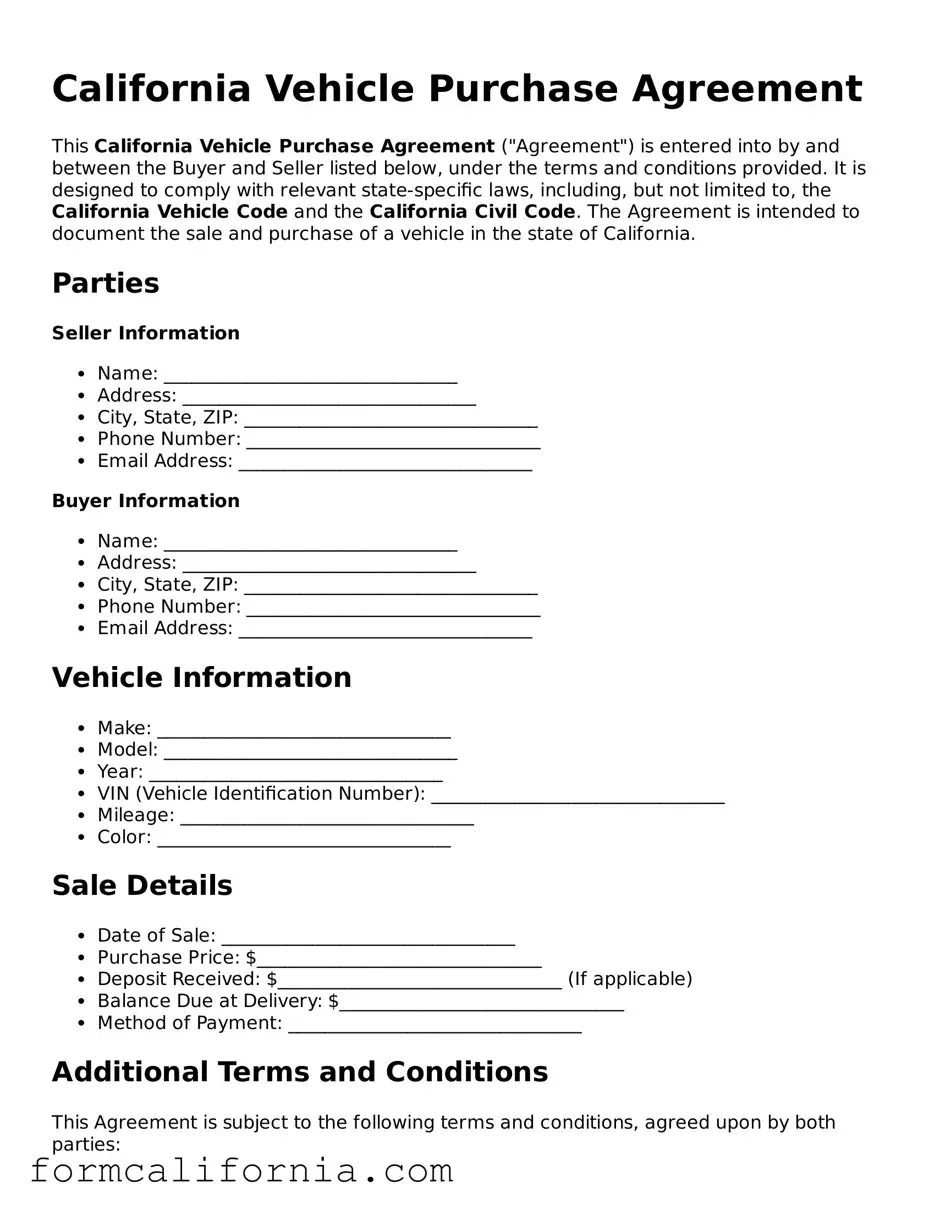The California Vehicle Purchase Agreement form shares similarities with the Bill of Sale document. Both documents are essential in the transfer of ownership of property - the Vehicle Purchase Agreement for vehicles and the Bill of Sale for a broader range of items including vehicles, boats, and personal property. They both include critical details such as the names and addresses of the buyer and seller, a description of the item being sold, the sale price, and the date of the sale. The key function of these documents is to provide proof of purchase and to specify the terms of the sale.
Another document similar to the California Vehicle Purchase Agreement form is the Residential Real Estate Purchase Agreement. This document is used in the transaction of purchasing a home or other residential property, detailing the terms and conditions of the sale. Like the vehicle purchase agreement, it includes information about the buyer and seller, the purchase price, and the description of the property. Both documents serve to protect the rights of the buyer and seller and to ensure that all terms of the sale are clearly understood and agreed upon.
The Lease Agreement is also related to the California Vehicle Purchase Agreement in purpose and structure. While the Lease Agreement concerns the rental of property rather than its sale, it similarly outlines the terms agreed upon by two parties - the lessee and the lessor. These terms include duration of the lease, payment amount, and conditions of use. Both agreements are legally binding and require the parties to adhere to the terms set forth within the document.
The Warranty Deed is a document used in real estate to guarantee that the title to the property is clear and that the seller has the right to sell the property. Like the California Vehicle Purchase Agreement, it protects the buyer's interests by ensuring the property is transferred free of liens or other encumbrances. Both documents play crucial roles in providing peace of mind to the buyer by verifying the legitimacy of the sale and the condition of the property or item being sold.
A Loan Agreement shares the function of specifying terms and conditions between parties, much like the California Vehicle Purchase Agreement. However, the Loan Agreement pertains to the borrowing of money, detailing the loan amount, interest rate, repayment schedule, and any collateral involved. While differing in context, both agreements are pivotal in clearly laying out the obligations of each party and protecting their interests in the transaction.
The Business Sale Agreement is another document that bears resemblance to the California Vehicle Purchase Agreement, tailored to the sale of businesses. It includes specifics such as the assets being purchased, the sale price, and any conditions or warranties. Both documents ensure that every aspect of the sale is recorded in writing, safeguarding both buyer and seller against future disputes by delineating the agreed-upon terms.
Similar to the California Vehicle Purchase Agreement is the Promissory Note, which documents a promise to pay a specified sum of money to a named person at a determined time. Though it typically concerns the borrowing of money rather than a sale, the clarity and commitment in the agreement mirror the nature of a vehicle purchase contract. Both agreements detail financial obligations and are enforceable, providing legal recourse in the event of non-compliance.
The Retail Installment Contract is akin to the California Vehicle Purchase Agreement when financing is involved. This document is used in transactions where the buyer does not pay the full purchase price upfront but rather over a period of time, specifying the total purchase price, including interest and other charges. Like the vehicle purchase agreement, it breaks down the financial aspects of the agreement, offering protection and clarity for both the buyer and the seller throughout the payment process.
